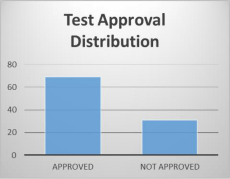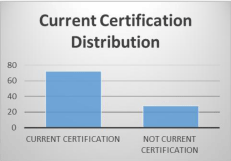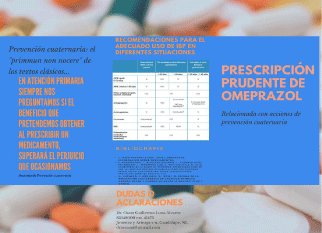Abstract
Background: Quaternary prevention is the "primum non nocere" of classical medicine, and in general, a drug is considered appropriate when it presents clear evidence that supports its use in an adequate indication.
Aim: The purpose of this study is to know the level of knowledge about quaternary prevention actions related to the use of omeprazole.
Design and Setting: educational session before and after.
Methods: In 76 participants in the Family Medicine Unit #32, Nuevo Leon, Mexico; an educational session before and after was conducted in family doctors and residents doctors. We obtained general data such as age, sex, level of knowledge about adequate prescription of omeprazole in older adults, years worked, current certification, working hours and academic degree (resident doctor). For statistical analysis, we applied descriptive statistics; for qualitative variables frequencies and percentages were used and for quantitative variables mean and standard deviation were used.
Results: The score obtained in the initial evaluation was 60.2 points; in the second evaluation, after the informative session, the average score of the participants was 83.8 points.
Conclusion: It is important that the primary care doctor has an adequate level of knowledge in the adequate prescription of any medication, not just the proton pump inhibitors.
Keywords: STOPP Criteria; Quaternary Prevention; Inappropriate Drug Prescription; Omeprazole
Introduction
Proton Pump Inhibitors (PPIs) are widely used drugs. They act by inhibiting the H/K-ATPase enzyme from the parietal cells of the gastric mucosa and, consequently, diminish acid secretion. This irreversible inhibition means that, although its half-life in plasma is short (from 1 to 2 hours), its effect is more prolonged when the synthesis of new proton pumps is required to reactivate the acid secretion [1]. Quaternary prevention is the set of interventions that avoids or attenuates the consequences of unnecessary or excessive activity of medical interventionism. The concept was introduced by the Belgian doctor Marc Jamoulle and was incorporated into the general and family medicine dictionary of the WONCA and concerns both primary care and hospital care. If we accept that the most important medical activity is the “primum non nocere”, quaternary prevention should stand out more than another type of prevention. Quaternary prevention is a social issue in the current context of increasing medicalization [2].
The success of pharmacotherapy is based on the correct choice of the drug and its administration in appropriate doses, directed at the specific disease or disorder, for the ideal patient. Inadequate prescription of medications contributes to increased adverse drug events and inadequate monitoring [1]. A distinction must be made between appropriate and inappropriate polypharmacy, that is, the consumption of many drugs but all of them with a clinical indication and the consumption of more drugs than are clinically necessary; the factors related to inappropriate polypharmacy include biological, psychological and social factors, but also of the prescribing physician and the health system [3]. Epidemiological studies conducted in Europe and North America have used criteria to determine the prevalence of Inappropriate Prescription of Drugs (IDP) in elderly patients, with results ranging between 11 and 65% depending on the population studied. In Canada, a study conducted in hospitalized patients with acute disease, found a prevalence of IDP of 12.5%. Another study in Ireland found that 22% of hospitalized patients with acute disease had at least one inappropriate drug according to these criteria [4].
Some studies conducted in hospitals in Spain showed that patients receiving a proton pump inhibitor had a higher prevalence of fragility fracture than those without such treatment [5]. In general, a drug is considered appropriate when it presents clear evidence that supports its use, are well tolerated in most patients and are costeffective. In addition, adequate prescription in older adults should take into account individual life expectancy, avoiding preventive therapies in patients with a short survival prognosis and promoting drugs with favorable benefit-risk ratio [2]. It is estimated that Adverse Drug Reactions (ADRs) are responsible for 30% of hospital admissions in elderly patients; the main cause of ADR in this age group is inappropriate prescription of drugs and poor monitoring of prescribed treatments [6]. Based on the above, the main objective of the study is to know the level of knowledge about quaternary prevention actions related to the use of omeprazole.
Materials and Methods
An informative session (before and after study) was carried out, in the Family Medicine Unite #32, of the Instituto Mexicano del Seguro Social (IMSS), located in Nuevo Leon, Mexico; the participants were selected by a total census; they met the following inclusion criteria: any age and sex, family doctors, resident doctors of the specialty of family medicine, work in family medicine unit #32 and have prescribed omeprazole in previous recipes; family doctors assigned to the continuous medical care service (emergencies), family doctors during vacation period or incapacitated were excluded and patients with incomplete information were eliminated. The following data were obtained directly from participants: age, sex, level of knowledge about adequate prescription of Omeprazole in older adults, years worked, current certification, working hours and academic degree (resident doctor).
The procedure for the data collection was as follows: age was calculated in years according to the year of birth; sex was determined by the phenotype characteristics of each individual; level of knowledge about adequate prescription of Omeprazole in older adults was determined by an application of a diagnostic test in electronic format based on START-STOPP criteria on the use of omeprazole; a second application of the same test after the informative session was made in order to compare knowledge before and after intervention, the level of knowledge was divided into approving the score of 70 or more and not approving 69 and fewer points; years worked was calculated with the date of entry to the IMSS; current certification was evaluated with the date of last certification, working hours was divided into morning (8 am - 2 pm) and evening (2 pm - 8 pm) and academic degree (resident doctors) was evaluated with the year of admission to the residence (R1, R2, R3).
The recollected data was integrated into data collection sheets and analyzed using the Epi-info program, where we applied descriptive statistics; for qualitative variables, frequencies and percentages were used and for quantitative variables, mean and standard deviation were used. The Kolmogorov-Smirnoff test was used to establish the normality of the data. The Protocol was authorized by the Local Committee of Research and Ethics in Health Research.
Results
The sample obtained in the present study was 76 participants, corresponding to the distribution of family doctors and resident doctors; a frequency of 22 family doctors and 54 resident doctors was observed. The distribution of resident doctors by academic degree was as follows: 18 first-degree residents (R1), 19 second-grade residents (R2) and 18 third-degree residents (R3). Within the years of work of the participants based on the date of admission to the IMSS, the following distribution was made by groups: group one, less than one year; group two, from two to five years old; group three, from six to 10 years old and group four, more than 11 years old. Group two was the most frequent (n=52, 68.4%) (Graphic 1).

Graphic 1: Descriptive analysis of the distribution by years working.
The initial evaluation was made to the study participants; the qualification of 70 points or more was considering approving and not approving 69 points or less. The percentage of participants who did not pass the exam was 68.4% (Graphic 2) and the average of the initial evaluation was 60.2 points. After the informative session by physical and digital triptych, the evaluation was again carried out where a general average of 83.86 points was obtained for the 76 participants. 72% of family doctors have current certification (Graphic 3).

Graphic 2: Descriptive analysis of the distribution by test approval.

Graphic 3: Descriptive analysis of the distribution by current certification.
Discussion and Conclusion
The application process of the questionnaire had limitations in its physical form, for this reason, to speed up its application, an electronic questionnaire was created through the Internet application "Google Forms". With this electronic application, the way of interpreting the results was provided for each question that was applied (Graphic 4). The entire process was confidential and evaluated the knowledge before and after the information session carried out individually to each family doctor. Based on the results, an average of 60.2 points was found in the first evaluation; in the second evaluation the knowledge average improved 20 points (83.8) after the delivery of the informative pamphlet, which shows a close relationship between the clinical and critical thinking. It is important that the primary care doctors be aware of the proper prescription of drugs, not just the proton pump inhibitors (omeprazole).

Graphic 4: Educational material of the informative session (Part 1).

Graphic 4: Educational material of the informative session (Part 2).
References
- De-la-Coba C, Argüelles-Arias F, Martín-de-Argila C, Júdez J, Linares A, Ortega-Alonso Aida, et al. Proton-pump inhibitors adverse effects: a review of the evidence and position statement by the Sociedad Española de Patología Digestiva. Rev. esp. enferm. dig. 2016; 108: 207-224.
- Cucalón JM, Guiu M. El enigma de la prevención cuaternaria en atención primaria.Cuándo hacer y cuándo no hacer (a propósito de 2 casos). SEMERGEN. 2013; 39: 313-315.
- Filomena-Paci J, García-Alfaro M, Redondo-Alonso FJ, Fernandez-San- Martin MI. Prescripción inadecuada en pacientes mayores de 64 años en atención primaria. Aten Primaria. 2015; 47: 38-47.
- Delgado-Silveira E, Muñoz-Garcia M, Montero-Errasquin B, Sanchez- Castellano C, Gallagher PF, Cruz-Jentoft AJ. Prescripción inapropiada de medicamentos en los pacientes mayores: los criterios STOPP/START. Rev Esp Geriatr Gerontol. 2009; 44: 273-279.
- Prescripción Farmacológica Razonada para el Adulto Mayor. Guia de practica clínica, México: Secretaría de Salud. 2010.
- Gomez-Santana MC, Gavilan-Moral E, Villafaina-Barroso A, Jimenezde Gracia L. Prescripción prudente y deprescripción de fármacos como herramientas para la prevención cuaternaria. Rev Bras Med Fam Comunidade. 2015; 10: 1-8.
